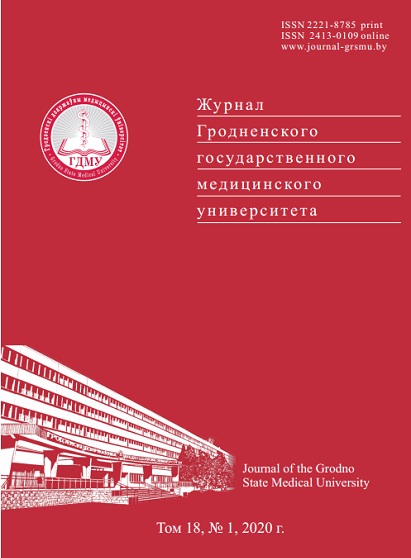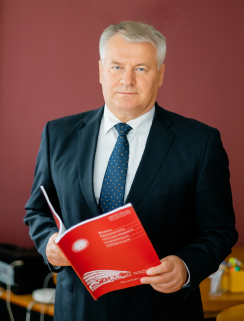ИНВАЗИВНЫЕ МИКОЗЫ В ОТДЕЛЕНИЯХ ИНТЕНСИВНОЙ ТЕРАПИИ
Аннотация
Введение. Количество пациентов в отделениях реанимации, имеющих инвазивные микозы, в последние годы увеличилось. Это связано с внедрением инвазивных методов лечения, c иммуносупрессивной терапией, трансплантацией органов, а также c успехами в диагностике инфекций. Цель. Проведен анализ литературы с целью изучения современных подходов к этиотропной и патогенетической терапии инвазивных микозов среди пациентов реанимационных отделений. Материал и методы. Проанализирован 31 литературный источник. Результаты. Получены современные сведения о методах клинической и лабораторной диагностики и фармакологических агентах для лечения инвазивных микозов. Выводы. Один из приоритетов в борьбе с инвазивными микозами среди пациентов отделений интенсивной терапии – своевременная диагностика грибковой инфекции с профилактической терапией или таргетным воздействием на установленный источник инвазивного микоза.
Литература
Ostrosky-Zeichner L, Al-Obaidi M. Invasive fungal infections in the intensive care unit. Infect. Dis. Clin. North Am. 2017;31(3):475-487. http://doi.org/10.1016/j.idc.2017.05.005.
Cuenca-Estrella M, Kett DH, Wauters J. Defining standards of CARE for invasive fungal diseases in the ICU. J. Antimicrob. Chemother. 2019;74(Suppl 2):9-15. http://doi.org/10.1093/jac/dkz038.
Jose P, Alvarez-Lerma F, Maseda E, Olaechea P, Peman J, Soriano C, Zaragoza R. Invasive fungal infection in critically ill patients: hurdles and next challenges. J. Chemother. 2019;31(2):64-73. http://doi.org/10.1080/1120009X.2018.1557799.
Xiao Z, Wang Q, Zhu F, An Y. Epidemiology, species distribution, antifungal susceptibility and mortality risk factors of candidemia among critically ill patients: a retrospective study from 2011 to 2017 in a teaching hospital in China. Antimicrob. Resist. Infect. Control. 2019;8(89):1-7. http://doi.org/10.1186/s13756-019-0534-2.
Quindos G. Epidemiology of invasive mycoses: a landscape in continuous change. Rev. Iberoam. Micol. 2018;35(4):171-178. http://doi.org/10.1016/j.riam.2018.07.002. (Spanish).
Arendrup MC. Candida and candidaemia. Susceptibility and epidemiology. Dan. Med. J. 2013;60(11):1-32.
Israel S, Amit S, Israel A, Livneh A, Nir-Paz R, Korem M. The epidemiology and susceptibility of candidemia in Jerusalem, Israel. Front. Cell. Infect. Microbiol. 2019;9(352):1-7. http://doi.org/10.3389/fcimb.2019.00352.
Warris A. Candida auris, what do paediatricians need to know? Arch. Dis. Child. 2017;103(9):891-894. http://doi.org/10.1136/archdischild-2017-313960.
Cortegiani A, Misseri G, Fasciana T, Giammanco A, Giarratano A, Chowdhary A. Epidemiology, clinical characteristics, resistance, and treatment of infections by Candida auris. J. Intens. Care. 2018;6(69):1-13. http://doi.org/10.1186/s40560-018-0342-4.
Forsberg K, Woodworth K, Walters M, Berkow ML, Jackson B, Chiller T, Vallabhaneni S. Candida auris: The recent emergence of a multidrug-resistant fungal pathogen. Med. Mycol. 2019;57(1):1-12. http://doi.org/10.1093/mmy/myy054.
Karpun NA, Burova SA, Evdokimov EA, Chaus NI. Invazivnyj kandidoz v otdelenijah intensivnoj terapii [Invasive candidiasis in the intensive care unit]. Medicinskij alfavit. 2014;2(9):22-25. (Russian).
Ramirez P. Garnacho-Montero J. Invasive aspergillosis in critically ill patients. Rev. Iberoam. Micol. 2018;35(4):210-216. http://doi.org/10.1016/j.riam.2018.07.001. (Spanish).
Clancy CJ, Nguyen MH. Diagnosing invasive candidiasis. J. Clin. Microbiol. 2018;56(5):1909-1917. http://doi.org/10.1128/JCM.01909-17.
Clancy CJ, Nguyen MH. Finding the “missing 50%” of invasive candidiasis: how nonculture diagnostics will improve understanding of disease spectrum and transform patient care. Clin. Infect. Dis. 2013;56(9):1284-1292. http://doi.org/10.1093/cid/cit006.
Garcia J, Peman J. Microbiological diagnosis of invasive mycosis. Rev. Iberoam. Micol. 2018;35(4):179-185. http://doi.org/10.1016/j.riam.2018.05.003. (Spanish).
Levesque E, Rizk F, Noorah Z, Aпt-Ammar N, CordonnierJourdin C, El Anbassi S, Bonnal C, Azoulay D, Merle JC, Botterel F. Detection of (1,3)-β-d-glucan for the diagnosis of invasive fungal infection in liver transplant recipients. Int. J. Mol. Sci. 2017;18(4):862. http://doi.org/10.3390/ijms18040862.
de Heer K, Gerritsen MG, Visser CE, Leeflang MM. Galactomannan detection in broncho-alveolar lavage fluid for invasive aspergillosis in immunocompromised patients. Cochrane Datab. Syst. Rev. 2019;(5):CD012399. http://doi.org/10.1002/14651858.CD012399.pub2.
Christensson B, Larsson L. Arabinitol ratio in urine for early diagnosis of Candidiasis infection. Lakartidningen. 2008;105(48-49):3537-3538. (Swedish).
Leon C, Ruiz-Santana S, Saavedra P, Castro C, Loza A, Zakariya I, Ubeda A, Parra M, Macias D, Tomas JI, Rezusta A, Rodriguez A, Gomez F, Mazuelos EM. Contribution of Candida biomarkers and DNA detection for the diagnosis of invasive candidiasis in ICU patients with severe abdominal conditions. Crit. Care. 2016;20(149):1-14. http://doi.org/10.1186/s13054-016-1324-3.
Leon C, Ruiz-Santana S, Saavedra P, Almirante B, NollaSalas J, Alvarez-Lerma F, Garnacho-Montero J, Leon MA. A bedside scoring system (“Candida score”) for early antifungal treatment in nonneutropenic critically ill patients with candida colonization. Crit. Care Med. 2006;34(3):730-737. http://doi.org/10.1097/01.CCM.0000202208.37364.7D.
Umberger R, Garsee K, Davidson B, Carringer JA, Kuhl D, Muthiah MP. The utility of the Candida score in patients with sepsis. Dimens. Crit. Care Nurs. 2016;35(2):92-98. http://doi.org/10.1097/DCC.0000000000000163.
Veselov AV. Jempiricheskaja terapija invazivnogo kandidoza v otdelenijah reanimacii i intensivnoj terapii: sovremennoe sostojanie problemy [Empiric Therapy of Invasive Candidiasis in Intensive Care Units: Current State of Problem]. Klinicheskaja mikrobiologija i antimikrobnaja himioterapija [Clinical microbiology and antimicrobial chemotherapy]. 2011;13(1):4-18. (Russian).
Maseda E, Rodriguez AH, Aguilar G, Peman J, Zaragoza R, Ferrer R, Llinares P, Grau S. Recommendations on invasive candidiasis in patients with complicated intra-abdominal infection and surgical patients with ICU extended stay (EPICO 3.0.). Rev. Iberoam. Micol. 2016;33(4):196-205. http://doi.org/10.1016/j.riam.2016.02.003.
Chatelon J, Cortegiani A, Hammad E, Cassir N, Leone M. Choosing the right antifungal agent in ICU patients. Adv. Ther. 2019;36(12):3308-3320. http://doi.org/10.1007/s12325-019-01115-0.
Veselov AV. Antimikotiki dlja sistemnogo primenenija: kljuchevye aspekty dlja klinicista [Antifungal agents for systemic use: key aspects for clinicians]. Farmateka. 2015;16:96-103. (Russian).
Veselov АV. Obzor rekomendacij po terapii i profilaktike invazivnogo kandidoza u detej i novorozhdennyh [Review of the guidelines for the treatment and prevention of invasive candidiasis in newborns and children]. Klinicheskaja mikrobiologija i antimikrobnaja himioterapija [Clinical microbiology and antimicrobial chemotherapy]. 2017;19(2):92-100. (Russian).
Chen YH, Cheng IL, Lai CC, Tang HJ. Echinocandins vs. amphotericin B against invasive candidiasis in children and neonates: A meta-analysis of randomized controlled trials. Int. J. Antimicrob. Agents. 2019;53(6):789-794. http://doi.org/10.1016/j.ijantimicag.2019.02.019.
Koch C, Schneck E, Arens C, Markmann M, Sander M, Henrich M, Weigand MA, Lichtenstern C. Hemodynamic changes in surgical intensive care unit patients undergoing echinocandin treatment. Int. J. Clin. Pharm [Internet]. 2019 Nov 21:1-8. Available from: https://doi.org/10.1007/s11096-019-00939-8.
Kofla G, Ruhnke M. Pharmacology and metabolism of anidulafungin, caspofungin and micafungin in the treatment of invasive candidosis: review of the literature. Eur. J. Med. Res. 2011;16(4):159-166. http://doi.org/10.1186/2047-783x-16-4-159.
Leverger G, Timsit JF, Milpied N, Gachot B. Use of micafungin for the prevention and treatment of invasive fungal infections in everyday pediatric care in France: results of the MYRIADE study. Pediatr. Infect. Dis. J. 2019;38(7):716-721. http://doi.org/10.1097/INF.0000000000002353.
Keane S, Geoghegan P, Povoa P, Nseir S, Rodriguez A, Martin-Loeches I. Systematic review on the first line treatment of amphotericin B in critically ill adults with candidemia or invasive candidiasis. Expert. Rev. Anti. Infect. Ther. 2018;16(11):839-847. http://doi.org/10.1080/14787210.2018.1528872.































